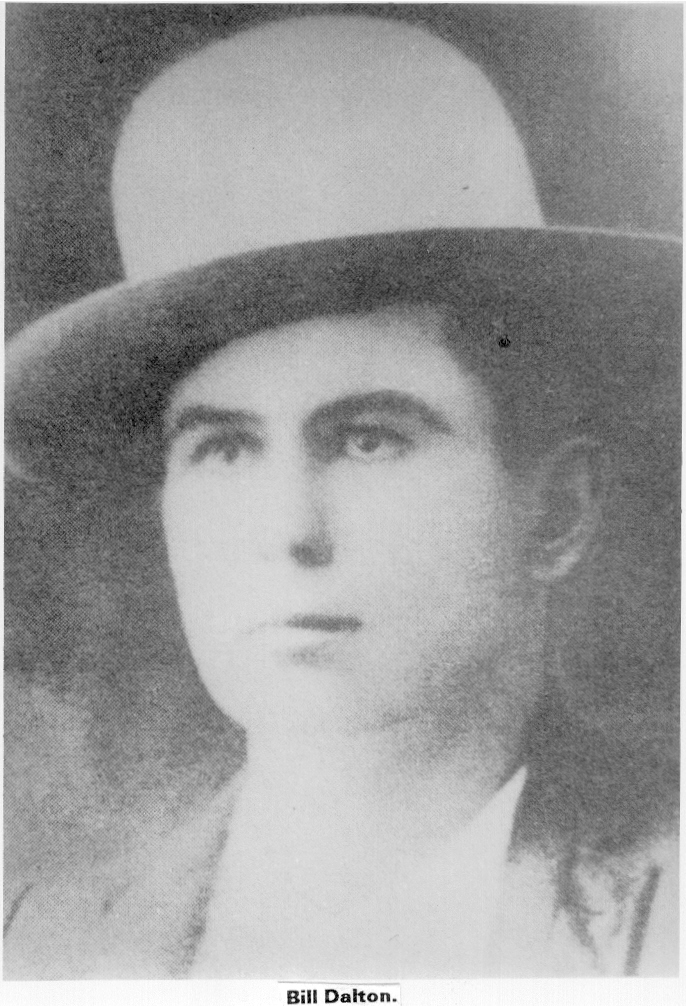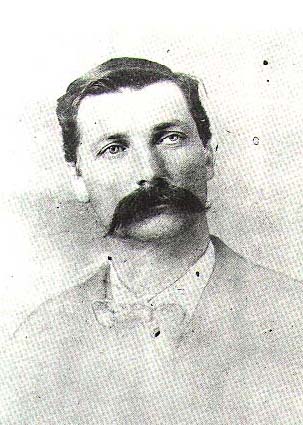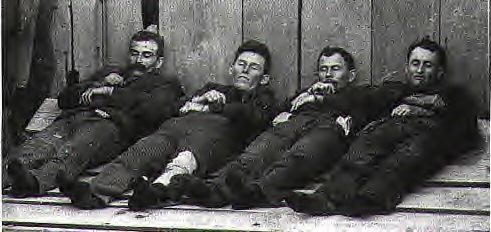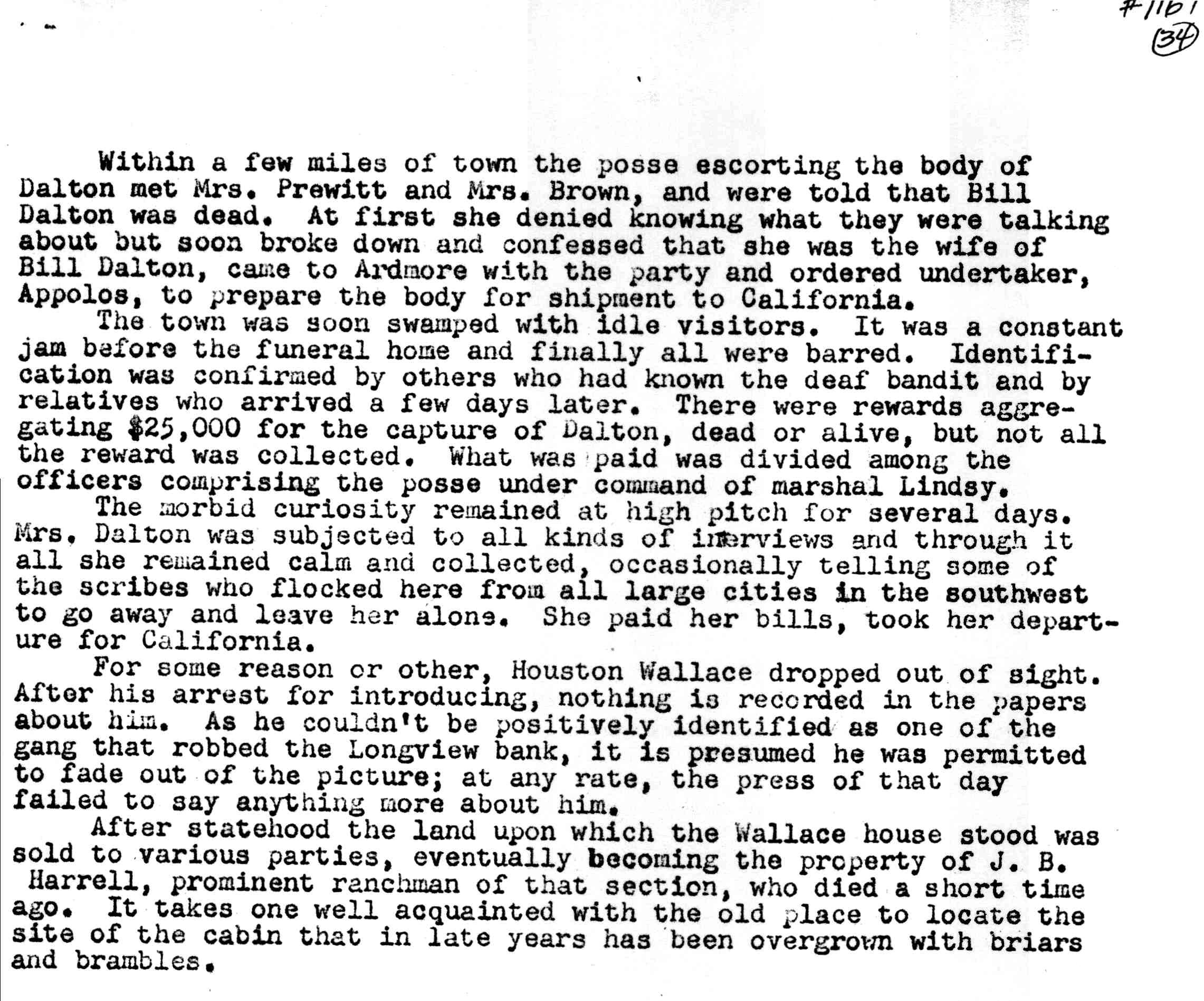The Killing of Bill Dalton
 Bill Dalton about age 33.
Bill Dalton about age 33.

Prelude to Disaster!
In the late 1800's in Indian Territory, there were many outlaw gangs that were made up of brothers. Some of these were the Miller, Lee, Marlow, Younger, James and the subject of our sketch today, the Dalton brothers.
One of the curiosities of this family is that Frank Dalton was a Deputy U.S. Marshal in Indian Territory who gave his life in the line of duty in 1884. Grattan, or Grat as he was called, and Bob were also deputy U.S. Marshals and often rode with Frank. Emmett was a kid at this time and just rode along with his older brothers in the posse.
After Frank was killed, the remaining three brothers started a life of crime. Or, could it have been "returned to" a life of crime. Bob who was wounded in 1888 while a marshal, had also killed a man in a lover's triangle and is said to have been in the horse stealing business while still a marshal. When some stolen horses were trailed to Kansas, Bob, Grat and Emmett decided they needed a vacation in California to visit their brother Bill.
The trip was uneventful until three masked gunmen held up the Southern Pacific RR near Tulare, California. Bill proved his alibi but Grat could not and was convicted of robbery and sentenced to Folsom Prison. Grat somehow obtained the keys to his cell and escaped while waiting to go to prison and with his brothers Bob and Emmett, high-tailed it back to Kingfisher, O.T.
It is said that Bob was the wild one and was the ringleader of the outlaw brothers. He included the likes of Bill Doolin, Dick Broadwell and Blackface Charley Bryant. Charley got his moniker because he had a black powder gun blow up in his face.
In the early 1890's, the Daltons rode out of Kingfisher, O.T. to spread their rein of terror. On their ill fated and ill-conceived trip to Coffeyville, Kansas, they attempted to rob two banks at the same time. Now folks, the Dalton Brothers were raised in Coffeyville. Everybody in that small town knew them by site. Everybody knew that they were bank and train robbers.
How dumb do you have to be to rob a bank in your hometown? It is no wonder that every available citizen was armed and waiting for them outside the two banks. Bob and Grat were killed in the armed melee that resulted and Emmett was seriously wounded but survived to serve a stretch in the Lansing pen for robbery. After being pardoned by the Kansas governor, Emmet went to California and became a technical advisor in the making of western movies.
This is where Bill Dalton enters the picture. After the shootout, Bill was notified to come take care of his brother's final affairs. Some say that Bill lived in California at the time of the robbery but when Bill was killed, Marshals found letters addressed to his wife in California and mailed from Oklahoma Territory months before the Coffeyville Raid. Bill may have been in the country well before the raid.
Upon arrival at Coffeyville, Bill was incensed to find that souvenir hunters had taken all the personal possession that his brothers had on them. This personal property of the boys was passed around or sold like tokens from a county fair. This incident is believed to have been a major factor as to why Bill took the path he choose after the death of his brothers.
Others say it was the bad blood the boys inherited from their mother. You see, their mother Adeline was a Younger, the aunt of Cole, Bob and Jim Younger and a cousin of Frank and Jesse James. The Daltons had moved to Coffeyville from Missouri at the beginning of the Civil War to escape the ravages that were known to be coming. The Dalton boys grew up listening to stories of their famous or infamous relatives.
With the opening of the Oklahoma Territory in 1889, Lewis and Adeline Dalton made the run like so many others into the new land settling near Kingfisher, O.T. Charles, Littleton and Henry also made claims near Kingfisher to be near their father. There were 15 children in the Dalton family and only Bob, Bill, Grat and Emmett turned to a life of crime. Their siblings were solid, productive citizens in Oklahoma Territory.
Bill Dalton was a respected businessman in California and is said to have even served in the California legislature. He lived in a beautiful two-story home surrounded by palm trees. Bill would later be buried in the front yard of his home.
After the Coffeyville Raid, Bill reorganized the remaining gang with Bill Doolin, Arkansas Tom, George Newton, and Tulsa Jack. Later Three-fingered Dynamite Dick joined the gang. Evidently back then you couldn't be a successful outlaw without a really catchy nickname. The headquarters for the gang was in the town of Ingles in the CherOKee Strip.
On Sept. 1st, 1893, the gang was in a saloon drinking when several lawmen and townsmen surrounded the place. Arkansas Tom was captured but the rest of the gang, all wounded, escaped the shootout. The gang laid low and recovered from their wounds for the next few months. In May of 1894, the gang would ride again to rob the Longview, Texas bank. This would be their last crime and the unsigned bank notes taken in this robbery would prove to be their downfall.
The Shootout at Elk, I.T.
After the Coffeyville Raid by the
Dalton brothers with the death of Bob and Grat and the wounding of Emmit,
the remainder of the gang scattered. Brother Bill would gather the old
gang members Bill Doolin, "Tulsa Jack" Blake, "Bitter
Creek" Newcomb and Charley Pierce and begin a new reign of bandit
terror in the territory. The shootout at Ingles in the CherOKee
Strip on September 1, 1893 left the entire gang wounded, some severely but
only "Arkansas Tom" was captured.
The last raid committed by the last Dalton outlaw occurred on May 23,
1894. At 3:00 p.m., two roughly dressed men appeared at the desk of
the president of the First National Bank of Longview, Texas. One of
the men handed President Clemmons a note that read: "This will
introduce you to Charles Spreckelmeyer, who wants some money and he is
going to have it. B. and F." The interesting thing about
this name is that there was a family named Spreckelmeyer living in Ardmore
at that time.
Mr. Clemmons looked up to find he was looking down the bore of a
Winchester. The robbers got away with $2,000 in ten-dollar bank
notes and nine twenty-dollar bills. Now you have to remember this
was way before the Federal Reserve System when banks issued their own
currency as well as the National Currency. The president and the
treasurer of the bank usually signed banknotes by hand with pen and
ink. The reason the exact number of bills was known is that the
money taken was in new, uncirculated bills issued by the bank with many of
them yet unsigned. Legend, rumor and outright fabrication has given
the total take as somewhere between $2,000 and $4,500.
The City Marshal learned of the robbery in progress and assembled the
citizens of Longview and the proverbial gun battle between the bad men and
the good town folks ensued. Exiting the bank, a fusillade of fire
poured down on the bandits. The bandits forced the bank employees to go
into the street first. While the posse was busy shooting at the bank
president and tellers, the bandits mounted up and rode away unscathed. One
of the gang named Jim Wallace was at once struck down and mortally
wounded. As usual, just about everybody on the street near the bank
were killed or wounded with all the flying lead. Bill and the
remainder of the gang escaped.
The dead outlaw wore a hat with a label inside that read "W.O.
Dustin, Ardmore, I.T." The Longview sheriff telegraphed the
U.S. Marshal in Ardmore and gave a description of the man. After
some detective work it was determined that it was Jim Wallace who lived on
a ranch at Elk, thirty miles northwest of Ardmore in the Arbuckles.
Things quieted down for a few weeks after the robbery. On the
morning of June 7th, 1894, two women and a man came to Ardmore for some
shopping. They bought the usual items people used except they also
purchased an unusually large amount of ammunition of various
calibers. Also purchased was a suit of clothes for a man but it was
much larger than the size of the man accompanying the women.
This caused the clerk in the store to become suspicious and he began
examining the bank notes. He noticed they were new bills from the
First National Bank of Longview, Texas and several were not signed.
The clerk toOK the notes to the law who immediately telegraphed the
sheriff in Longview and the serial numbers of the notes matched the stolen
notes.
While all this commotion was going on with the bank notes, the U.S.
Marshals were notified that a suspicious package had arrived by train from
Texas at the freight depot. When the marshals opened it they found
three gallon barrels of whiskey. Introduction of whiskey into the
Indian Territory was a serious offense and the marshals toOK watch on the
freight depot to see who claimed the package.
Most of the day passed with the man and two women making the best of a
shopping spree spending a consideral amount of money. In the
afternoon the man appeared at the freight depot and claimed the package
containing the whiskey. At this point U.S. Marshal Seldon Lindsey arrested
the man who he recognized as Houston Wallace, brother of Jim Wallace, the
dead bandit at the Longview Bank robbery. Lindsey also toOK the two
women into custody who identified themselves as Mrs. Pruitt and Mrs.
Smith.
One of the women had $300 dollars hidden in her bosom and the other had
$400 hidden in her stocking also being loot taken in the Longview
robbery. Houston Wallace was locked up on introduction charges and
the women were to be detained until noon the next day. Lindsey
immediately formed a posse and
made plans to go to the Houston Wallace ranch in the Arbuckle Mountains
near Elk. (The post office name at Elk was changed to Pooleville
about 1906.)
There were rewards of about $35,000 offered by various organizations for
the capture of Bill Dalton, dead or alive. This was a huge amount of
money in 1896. A .44-.40 Winchester or Colt revolver could be bought
for $13 and ammunition was 1˝ cents per round. A Stetson hat cost
$4.50 and a good enough saddle cost $10. Land sold at this time for
about $1.25 per acre in Oklahoma Territory.
The rewards caused two marshals to form two separate posses to go to
Elk. The competing marshal, hoping to delay Lindsey's arrival at
Elk, got the confiscated whiskey and gave it to Lindsey's posse hoping to
get them drunk enough so they would pose no threat to his posse getting
the huge rewards. One man in Lindsey's posse passed out and fell dead
drunk on the way to
to the hideout. By the time the posse arrived at the Houston Wallace
ranch only Lindsey and Loss Hart were in good enough shape to perform
their task.
In the early morning of June 8th, 1894, Lindsey's posse, or what was left
of it, surrounded the Houston Wallace ranch house. The only
semi-sober posse man left was stationed in front of the house. All
was quite around the house as the sun began to break across the
Arbuckles. A man was observed playing in the front yard with four
children. A young girl went to the pasture to fetch the milk cow.
As the girl and the cow passed the ravine behind the house, she saw
Lindsey and Hart hiding in the ravine but walked quietly on to the house
pretending not to see them. She tied up the cow and yelled to the
man in the front yard playing with the children. The man ran to the
house and in a few seconds jumped out the back window with a pistol in his
hand. He ran a few hundred feet toward the timber and the ravine
when U.S. Marshal Lindsey called for him to surrender. The man
turned and fired his pistol at Lindsey in the ravine. At almost the
same instant both Lindsey and Hart fired their Winchesters at the fleeing
man. The first shot struck the man in the chest spinning him around
when the second shot hit him in the back with either
bullet proving fatal.
The man fell face down on the grass. Hart and Lindsey cautiously
approached the fallen victim. Slowly the man rolled over on
his back, smiled and breathed his last breath. Hart and Lindsey
recognized him as being Bill Dalton. Only three shots were fired and
the most feared and wanted man in the old west was taken. The last
of the Dalton gang was dead.
"Tulsa Jack" Blake died following the hold-up of the Rock Island
train at Dover, O.T. on May 5, 1895, at the hands of Marshal Chris
Madsen. "Bitter Creek" Newcomb and Charley Pierce died by
the hands of their friends at the outlaw hangout at Rock Fort Ranch with a
load of buckshot for each. Marshal
Bill Tilghman captured Bill Doolin in December of 1895 in Eureka Springs,
Arkansas in a bathhouse where Doolin had gone for treatment of
rheumatism. But Doolin escaped jail and Marshal Heck Thomas toOK
Doolin down the next year with a load of buckshot.
Who Killed Bill Dalton?
In the early morning hours of June 8th, 1894, on the Houston Wallace ranch in the Arbuckle Mountains, U.S. Marshals Loss Hart and Seldon Lindsey shot and killed Bill Dalton, the last of the Dalton Gang.
Dalton was wanted for the robbery of the Longview bank among many other bank and train robberies. There was an aggregate of $35,000 in rewards for Bill Dalton, dead or alive. It was common for the time for the posse to split the rewards of any captured felon. If the criminal was not captured, the posse got nothing for their trouble.
The officers went into the house after the shooting and pandemonium brOKe loose. The children were crying, the young girl was screaming and the other man seen at the window in the house had mysteriously disappeared. The marshals tried to console the children and assure them they would not be harmed. Young Gracie and Charles Dalton, age 6 and 8 were terror stricken at seeing their father killed.
The posse began searching the house for the money. It was stashed all over the log cabin but the major portion of the loot was nowhere to be seen. The marshals happened to remember that Bill Dalton had a particular fancy for trap doors and pulled a rug off the floor. Sure enough there was a trap door under the rug. Beneath the floor was a bank bag from the Longview bank containing $1,700. They had their proof that it was the Dalton gang that robbed the bank.
Also found in the cabin was the trunk of the Mrs. Smith who was detained in Ardmore. The lawmen found bundles of letters addressed to her, “Jane Dalton”, at Fresno, California and mailed from Oklahoma Territory. This is the cause for the reasoning that Bill was in this country well before his brother’s ill-fated raid on Coffeyville.
Dalton’s body was placed in a wagon belonging to Houston Wallace and the procession headed back to Elk to retrieve their horses. On the way back to Elk, the still dead drunk posse man was lying beside the road. The posse stopped and laid him in the wagon beside Dalton’s body.
Those of us who know how hot and humid it gets in the Arbuckles in the summer time can guess what was beginning to happen to Dalton’s body. The body was swollen so badly by the time the posse reached Milo, I.T. that they stopped at the well of Jim Alverson and poured twenty buckets of cool well water on the corpse in an attempt to reduce the swelling. This effort didn’t help the body much but did wash the blood off the clothing exposing the bullet hole in Dalton’s chest.
Buck Garrett had released the two women as instructed by Lindsey and the wagon with Dalton’s body and the wagon driven by Mrs. Pruitt and Mrs. Dalton (alias Mrs. Smith) loaded with supplies met on the road about five miles from Ardmore. The women were told that Bill Dalton had been killed but both women disclaimed any knowledge of the outlaw. As the two wagons passed and Jane Dalton saw her husband’s body lying in the back of the wagon she became hysterical. She was placed in the wagon with the body and returned to Ardmore with the posse. The body was taken to Appolla’s Funeral Home where an estimated crowd of 1,000 people pushed and shoved to see a last glimpse of the King of Western Outlaws. Ardmore quickly turned into a circus of reporters not unlike today.
This media frenzy is where the conjecture about the shooting came about. The second marshal and posse arrived well after the shootout at the Wallace Ranch. One of Lindsey’s posse men told this second marshal that Loss Hart had killed Dalton when in fact he couldn’t see who had done it because the shootout occurred behind the house. This second marshal is the person who told the press that Loss Hart had been the man. The only people to ever talked to the press about the shooting were the members of this second posse who were not even present when the shooting occurred. For some unknown reason Lindsey gave orders that the details would not be discussed.
Marshal Lindsey's instructions to his posse that no one was to ever give details of the shooting to the press and not one of them ever did. But, as today, the reporters who were hounded for details by their editors back home, began to “assume” a lot of facts that were simply not true at all. At Appolla’s undertaking establishment, a doctor removed the two bullets that were still in Dalton’s body. A .38/56 Winchester ball, a peculiar caliber, was removed from the heart of Dalton. A .44 Winchester ball was removed from Dalton’s back. Lindsey used a .38/56 and Loss Hart used a .44 Winchester. There was even some conjecture that the death photo of Dalton was not really of him because the man was too “fat”. Remember that the marshals were pouring well water on the corpse to keep the swelling down with little effect on that hot Arbuckle Mountain June day.
Who killed Bill Dalton? It really makes no difference. A man made a series of bad choices in his life and paid for it with the ultimate penalty. Jane Dalton’s husband and Gracie and Charles’ father was dead. The most hunted and feared outlaw of the 1890’s had seen his last sunrise.


